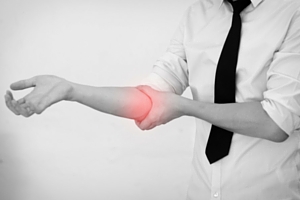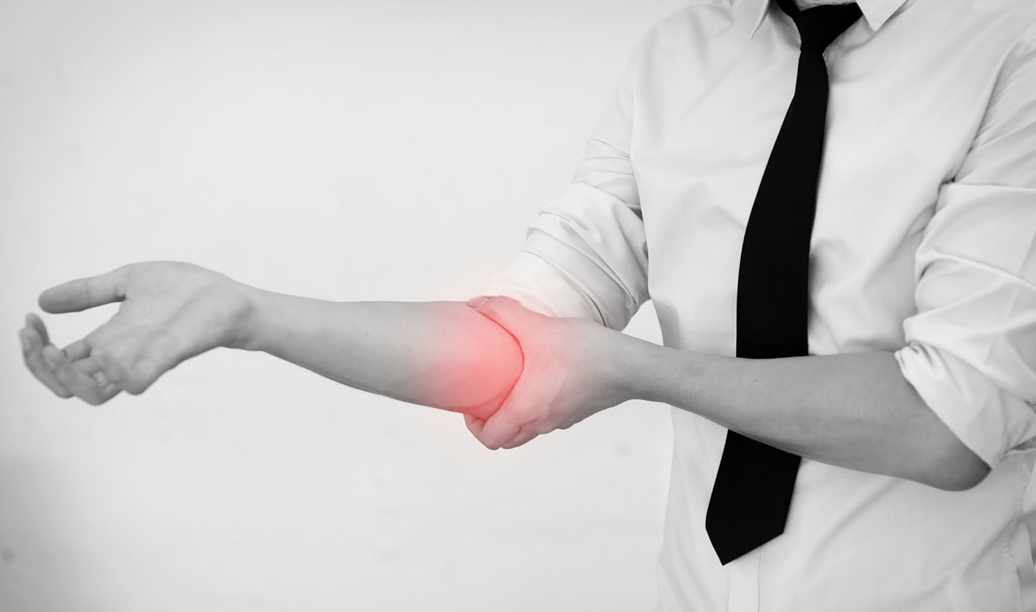
Occupational Overuse Syndrome (OOS) is also known as repetition strain injury (RSI). It is a term used to name a number of conditions with similar
symptoms that can include discomfort, pain, muscle fatigue, stiffness, numbness/tingling, burning sensations and weakness. Common among office workers is tennis elbow (lateral epicondylalgia or LE), which describes pain over the lateral (outside) region of the elbow and forearm. Once believed to be a result of chronic inflammation, it is now known that tennis elbow is characterised by many physical changes in the muscles, tendons and nerves of the whole arm and neck and is not caused by an inflammatory process.
Tennis elbow or LE typically presents over a period of months with the following factors placing individuals at high risk;
- Repetitive movements
- Awkward body postures
- Poorly designed workstations, tools and equipment
- Work organisations with fast-paced work and high pressures/ deadlines
- Returning to work after a long period of absence
Recent studies have revealed a widespread mechanical hypersensitivity in patients with tennis elbow, meaning the body’s perception of mechanical input (muscle contraction, stretch etc) is heightened. Those with tennis elbow report significantly higher pain levels to pressure over the muscles of the forearm, as well to cold temperatures, supporting a role of peripheral sensitisation mechanisms in the initiation or maintenance of symptoms. This suggests that a person with tennis elbow will experience a higher level of sensation intensity (eg pain/discomfort) for a given stimulus (eg typing, gripping); this is termed ‘sensitisation’. An example would be a pain response to typing after 30 seconds, handwriting a few lines or holding a handbag for a short duration.
The primary physical impairment in LE is a deficit in grip strength predominately due to pain and its consequences on motor function. Hence the mainstay of successful management of this condition is therapeutic exercise, providing it is not pain provocative. Evidence now shows that a progressive, structured strengthening program is more effective than non-steroidal medications and corticosteroids for tennis elbow. There is also a large body of evidence to support the role of isometric exercise (static holding exercises) in reducing pain, particularly in a ‘non-compressed’ position (with some elbow flexion). Static exercises place a gradual load on the tendons of the elbow region, which results in collagen remodelling.
It is important that the exercise program is monitored by a health professional (Accredited Exercise Physiologist or Physiotherapist) to ensure ongoing progression and return to full function. If workload and work ergonomics are optimised and the individual engages in a progressive exercise rehabilitation program, 70-80% of cases will recover in a 12 month period.
J Manipulative Physiol Ther. 2014 Feb;37(2):79-86. Bilateral cervical dysfunction in patients with unilateral lateral epicondylalgia without concomitant cervical or upper limb symptoms: a cross-sectional case-control study. Coombes BK1, Bisset L2, Vicenzino B3.
Man Ther. 2003 May;8(2):66-79. Lateral epicondylalgia: a musculoskeletal physiotherapy perspective. Vicenzino B.
Clin J Pain. 2009 Sep;25(7) Widespread mechanical pain hypersensitivity as sign of central sensitization in unilateral epicondylalgia: a blinded, controlled study. Fernández-Carnero J1, Fernández-de-Las-Peñas C, de la Llave-Rincón AI, Ge HY, Arendt-Nielsen L.
J Pain. 2011 Oct;12(10):1040-8. Topographical pressure and thermal pain sensitivity mapping in patients with unilateral lateral epicondylalgia. Ruiz-Ruiz B1, Fernández-de-Las-Peñas C, Ortega-Santiago R, Arendt-Nielsen L, Madeleine P.
Lateral epicondylalgia: a structured programme better than corticosteroids and NSAID September 2012, Vol. 19, No. 5 , Pages 404-410. Pia Nilsson, Amir Baigi, Leif Swärd, Margareta Möller, and Jörgen Månsson

